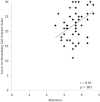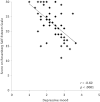Self-esteem in children and adolescents with hearing loss
- PMID: 25755025
- PMCID: PMC4355008
- DOI: 10.1177/2331216515572615
Self-esteem in children and adolescents with hearing loss
Abstract
Children with hearing loss are at risk for lower self-esteem due to differences from hearing peers relative to communication skills, physical appearance, and social maturity. This study examines the influence of generic factors unrelated to hearing loss (e.g., age, gender, temperament) and specific factors associated with hearing loss (e.g., age at identification, communication skills) on how children with hearing loss wearing cochlear implants or hearing aids appraise self-esteem. Fifty children with hearing loss wearing cochlear implants or hearing aids participated (Mean age: 12.88 years; mean duration of device use: 3.43 years). Participants independently completed online questionnaires to assess communication skills, social engagement, self-esteem, and temperament. Children with hearing loss rated global self-esteem significantly more positively than hearing peers, t = 2.38, p = .02. Self-esteem ratings attained significant positive correlations with affiliation (r = .42, p = .002) and attention (r = .45, p = .001) temperaments and a significant negative association with depressive mood (r = - .60, p < .0001). No significant correlations emerged between self-esteem and demographic factors, communication skills, or social engagement. Because successful communication abilities do not always co-occur with excellent quality of life, clinicians and professionals working with children with hearing loss need to understand components contributing to self-esteem to improve identification, counseling, and external referrals for children in this population.
Keywords: adolescents; children; cochlear implant; hearing loss; quality of life; self-esteem.
© The Author(s) 2015.
Figures




Similar articles
-
Psychosocial Development in 5-Year-Old Children With Hearing Loss Using Hearing Aids or Cochlear Implants.Trends Hear. 2017 Jan-Dec;21:2331216517710373. doi: 10.1177/2331216517710373. Trends Hear. 2017. PMID: 28752809 Free PMC article.
-
Use of technological aids and interpretation services among children and adults with hearing loss.Int J Audiol. 2017 Oct;56(10):740-748. doi: 10.1080/14992027.2017.1325970. Epub 2017 May 16. Int J Audiol. 2017. PMID: 28509597
-
Comparisons of visual attention in school-age children with cochlear implants versus hearing peers and normative data.Hear Res. 2018 Mar;359:91-100. doi: 10.1016/j.heares.2018.01.002. Epub 2018 Jan 9. Hear Res. 2018. PMID: 29370963 Free PMC article.
-
What can we expect of normally-developing children implanted at a young age with respect to their auditory, linguistic and cognitive skills?Hear Res. 2015 Apr;322:171-9. doi: 10.1016/j.heares.2014.09.002. Epub 2014 Sep 16. Hear Res. 2015. PMID: 25219955 Review.
-
Importance of role models and mentors for improving care for late-deafened adults who become cochlear implant recipients.Int J Audiol. 2024 Nov;63(11):837-843. doi: 10.1080/14992027.2024.2305676. Epub 2024 Jan 18. Int J Audiol. 2024. PMID: 38235743 Review.
Cited by
-
The effects of vestibular dysfunction on balance and self-concept in children with cochlear implants.Int J Pediatr Otorhinolaryngol. 2023 Aug;171:111642. doi: 10.1016/j.ijporl.2023.111642. Epub 2023 Jul 8. Int J Pediatr Otorhinolaryngol. 2023. PMID: 37429112 Free PMC article.
-
The Impact of Cochlear Implantation in Pediatric Patients on Quality of Life: A Systematic Review and Meta-Analysis.Otol Neurotol Open. 2025 Apr 17;5(2):e068. doi: 10.1097/ONO.0000000000000068. eCollection 2025 Jun. Otol Neurotol Open. 2025. PMID: 40599816 Free PMC article. Review.
-
Understanding identity construction among deaf adolescents and young adults: implications for the delivery of person and family-centered care in audiological rehabilitation.Front Rehabil Sci. 2023 Nov 1;4:1228116. doi: 10.3389/fresc.2023.1228116. eCollection 2023. Front Rehabil Sci. 2023. PMID: 38028156 Free PMC article.
-
Resilience promotes self-esteem in children and adolescents with hearing impairment: the mediating role of positive coping strategy.Front Psychol. 2024 Dec 20;15:1341215. doi: 10.3389/fpsyg.2024.1341215. eCollection 2024. Front Psychol. 2024. PMID: 39759409 Free PMC article.
-
Exploring the Correlations Between Measures of Listening Effort in Adults and Children: A Systematic Review with Narrative Synthesis.Trends Hear. 2023 Jan-Dec;27:23312165221137116. doi: 10.1177/23312165221137116. Trends Hear. 2023. PMID: 36636020 Free PMC article.
References
-
- Altshuler K. Z., Deming W. E., Vollenveider J., Rainer J. D., Tendler R. (1976) Impulsivity and profound early deafness: A cross cultural inquiry. American Annals of the Deaf 121: 331–345. - PubMed
-
- Bat-Chava Y. (1993) Antecedents of self-esteem in deaf people: A meta-analytic review. Rehabilitation Psychology 38: 221–234.
-
- Bat-Chava Y., Deignan E. (2001) Peer relationships of children with cochlear implants. Journal of Deaf Studies and Deaf Education 6: 186–199. - PubMed
-
- Berndt T. J., Keefe K. (1996) Relations of friendship quality to self-esteem in early adolescence. Journal of Early Adolescence 16: 110–129.
-
- Bishop J. A., Inderbitzen H. M. (1995) Peer acceptance and friendship: An investigation of their relation to self-esteem. Journal of Early Adolescence 15: 489.
Publication types
MeSH terms
LinkOut - more resources
Full Text Sources
Other Literature Sources
Medical

